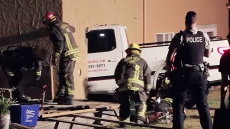VANCOUVER — The man who created a controversial statue of John A. Macdonald says he's pleased it's sparking a conversation about the country's horrific treatment of Indigenous Peoples, but there should have been public consultation on its removal.
The John A. Macdonald Historical Society commissioned artist John William Dann to create a sculpture of the first prime minister in 1981. It was given to the city as a gift and unveiled at the front entrance of Victoria City Hall on Canada Day in 1982, he said.
Dann said he is unaware of any consultation on its installation at the time, but he believes it was "destructive" to take it down last weekend without hearing from the public.
"If you want to move it, let's talk about it," he said in an interview Wednesday. "If it must become a sacrifice to the anger and frustration that Aboriginal people feel, fine let's tear it down — I'll be the first to smash it to pieces. But let's talk about it."
Victoria Mayor Lisa Helps announced last week that the city would be removing the statue because it serves as a painful reminder of the violence inflicted on First Nations at residential schools.
The action has sparked a national debate around how best to represent historical figures who made positive contributions to the country at the same time as sharing discriminatory or hateful perspectives more common to their time.
In 1883, Macdonald argued in the House of Commons for the removal of Indigenous children from their "savage" parents so they could learn the ways of white men.
Victoria's decision was reached by a council known as the "city family" that includes city councillors and members of local First Nations, following a year of discussion about how the city can best pursue reconciliation with local bands.
The move is not about erasing history, Helps said.
The sculpture will remain in storage until the city can figure out how to present it in a way that both celebrates Macdonald's contributions as Canada's first prime minister at the same time as acknowledging his harmful legacy in developing the residential school system, the mayor said.
Dann said he designed it not as a monument, but as a portrait of a man whose expression, "reveals something about all of us."
"It's not a sculpture on a pedestal, it's not a monument. It's a portrait of a man and that man is accessible to the people who go in and out of the building," he said. "It's not simply on a pedestal with a plaque, although that's the way most people still see it and I believe that's one of the reasons for this controversy."
Dann said it was his last such portrait because he realized that people tended to view it as a monument instead of recognizing it as art or a comment on humanity.
The way Canada has treated Indigenous peoples is "horrific," he said, and should be recognized.
But if the Macdonald sculpture is removed because of his role in the residential school system, Dann said he feared that would mean removing sculptures of almost every prime minister since him.
"Trudeau, Laurier, Mackenzie King. They all oversaw the support and the functioning of the residential schools. All of them," he said.
"So let's be realistic about our history. Let's acknowledge it, let's be ashamed of it by all means. But let's be realistic."
Environment Minister Catherine McKenna has asked the Historic Sites and Monuments Board of Canada to look at how to address concerns with historical figures like John A. Macdonald, whose role in establishing residential schools has made him a polarizing figure in Indigenous reconciliation efforts.
"I've tasked them to look at how do you have a thoughtful way with addressing concerns with certain people in our history, but you can't erase history," McKenna said.
"I personally believe that it's important that we recognize our history — the good and bad — and that we tell stories, because it's by telling stories we recognize that we can do better."




